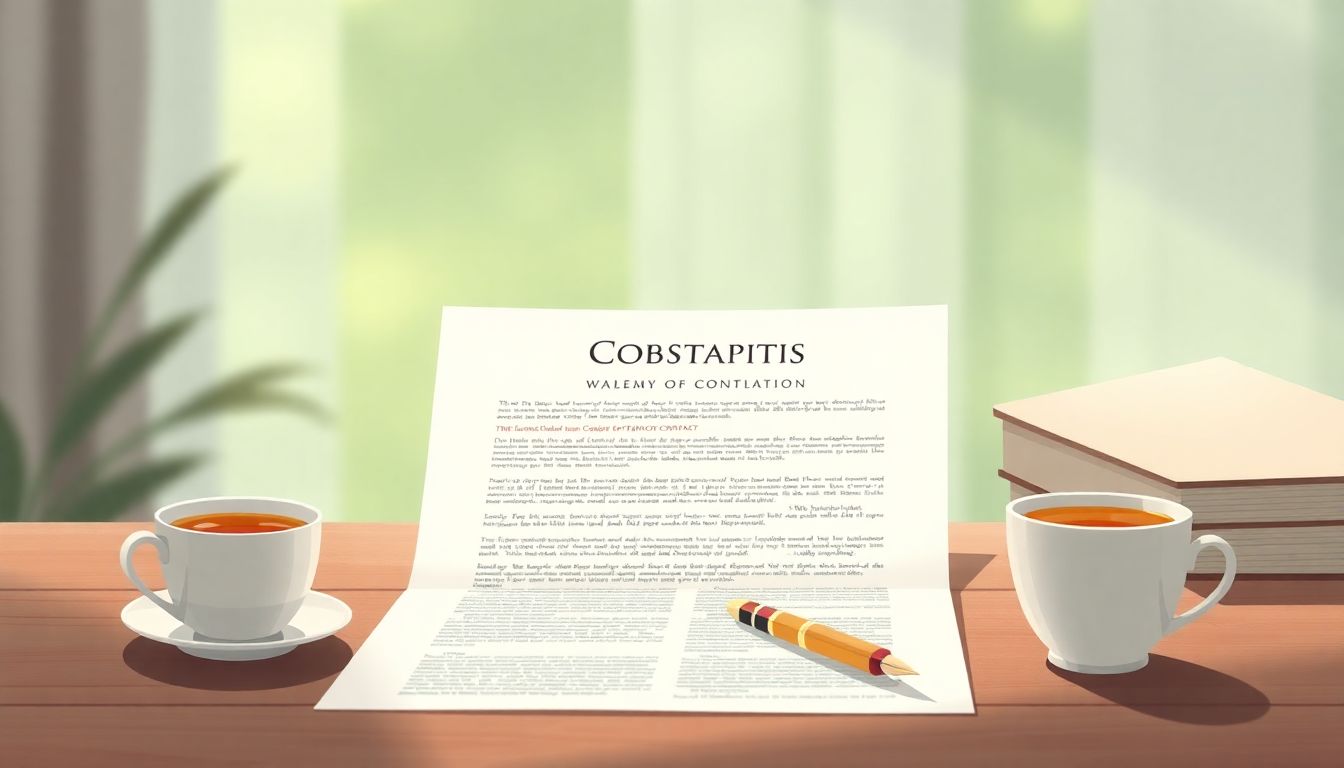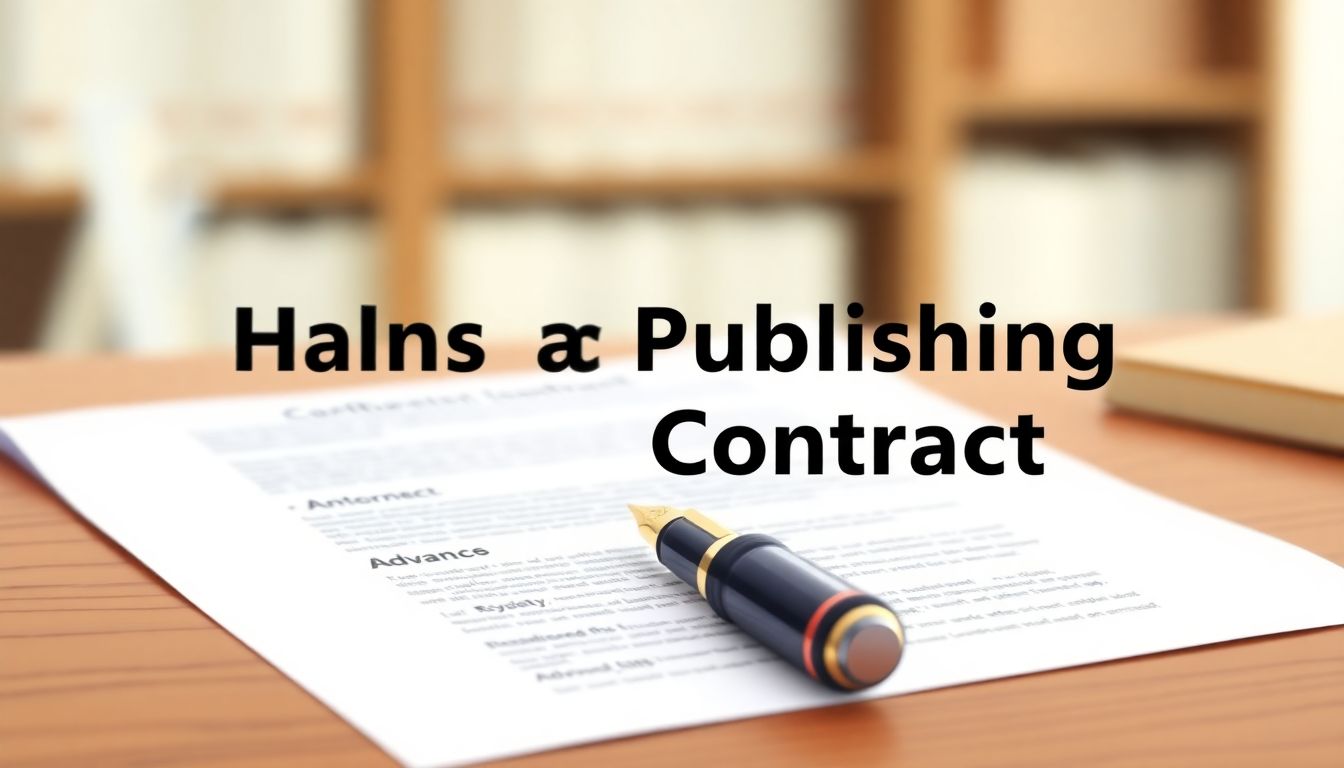Publishing contracts can feel intimidating—trust me, you’re not alone if the jargon makes your head spin. With pages full of legal language and unfamiliar terms, it’s easy to feel overwhelmed, confused, or even anxious about signing something that might impact the future of your creative work.
But here’s the good news: if you stick around, we’ll simplify things—walking through each part of your contract step-by-step, clearing up any confusion along the way. By the end, you’ll understand exactly what’s on the table and won’t need to worry about missing any sneaky fine print.
Ready? Here’s exactly what we’ll cover.
Key Takeaways
- A publishing contract is a legally binding agreement detailing rights, royalties, responsibilities, and payments between author and publisher.
- Clarify payment terms carefully—typical royalties are around 7.5%–15% for print, 20%–50% for digital formats, and advances vary widely.
- Know exactly what rights you’re giving up, such as e-book, audiobook, or film rights, and negotiate to retain ones valuable to you long-term.
- Check deadlines, required promotional activities, and author responsibilities closely to ensure you can comfortably meet all obligations.
- Always review termination clauses and contract durations (typically 5–7 years) thoroughly, making sure there’s a straightforward way to reclaim rights if sales decline.

Step 1: Understand What a Publishing Contract Is
A publishing contract is basically an official agreement between you—the author—and a publishing company outlining how both of you will work together and share profits from your book.
Think of it like setting ground rules for your partnership, detailing responsibilities, payments, and what’s expected to keep the relationship fair and clear.
Publishing contracts typically cover aspects like rights, royalties, payment schedules, deadlines, and what happens when things don’t go as planned.
Understanding your contract thoroughly is critical because once you sign it, you’re legally bound to whatever is in there, good or bad.
Spending some time learning about the basics of getting your book published without an agent can also give you additional context before jumping into negotiations.
Step 2: Know the Main Sections of a Publishing Contract
Most publishing contracts have several sections aimed to protect both the author and the publisher, and knowing them gives you a leg up when negotiating.
You’ll typically see sections dedicated to publishing rights, royalty payments, advances, deadlines, manuscript acceptance, licencing, warranties, and terms for ending the contract.
For instance, the royalties section will spell out exactly how much you’ll earn per book sold—say, around 7.5% to 15% in traditional publishing, according to current industry norms.
Pay special attention to the section on advances too, as an advance is an upfront payment you get when you sign your contract; this usually ranges significantly depending on your publisher and how sellable they think your book is.
Check thoroughly for the “termination clause” too—it’s your “escape hatch” if things sour and can save you big headaches down the line.
Step 3: Learn About Rights and Ownership
Your book is your baby—and signing a publishing contract means you’re deciding what rights you’re okay giving away and which ones you want to hold tightly.
Common rights publishers seek include print and electronic publishing rights, translation rights, audiobook rights, and even film rights.
It’s not unusual for contracts today to give you 20-50% royalties on e-books or between 25-50% for digital audiobooks, highlighting the importance of keeping an eye on digital formats and new media.
For instance, if you’re thinking about exploring audiobooks later on, you’d ideally negotiate to keep audiobook rights yourself so you can create and profit from your audiobook independently.
Also, keep an eye on how long your rights will belong to your publisher—most contracts have duration limits, usually until the book stops selling well or a predefined time passes.

Step 4: Familiarize Yourself With Advances, Royalties, and Payments
Let’s talk about the money stuff because, let’s be real, that’s super important when you’re signing a contract.
First up are advances, which are upfront payments publishers give you before your book hits the shelves.
These can range wildly depending on how popular the publisher thinks your book will be—typical first-time advances might be around $2,000 to $10,000, but they can be higher if you’re already known or your book looks especially promising.
The catch is you have to “earn out” this advance; that means your royalties from sales have to cover that amount before you start collecting additional royalties.
Speaking of royalties, traditional publishers commonly offer between 7.5% to 15% on print books; e-books tend to yield higher rates, usually between 20-35% on net revenue (here’s a helpful guide on typical e-book pricing).
Audiobooks are booming too, often earning authors 25-50% royalties on digital sales.
Payments usually happen twice per year; however, some publishers do quarterly statements.
Bottom line tip: Always ask about royalty rates for different formats, understand how “net revenue” is calculated, and discuss payment timelines clearly before signing on the dotted line.
Step 5: Identify Common Author Responsibilities and Warranties
A contract doesn’t just tell you what the publisher has to do—it’ll also lay out what’s expected from you as an author.
Typically, authors promise the manuscript they’re handing over is original and not previously published (pretty basic, right?).
You’ll also guarantee there’s no plagiarism going on, and you fully own the rights or have acquired all necessary permissions; otherwise, legal headaches are waiting.
Some contracts will also require participation in promotional activities like social media outreach, book signings, or interviews.
If you’re shy or introverted, clarify exactly what and how much promotional work you’re required to do.
A useful tip: Always double-check warranty clauses to be sure you’re comfortable with every promise you’re making—vague language can hurt you down the line.
Step 6: Understand Manuscript Requirements and Deadlines
Yes, deadlines can feel stressful, but knowing what’s expected and when is crucial.
Your contract will clearly outline when your manuscript needs to be complete, revisions deadlines, and possibly even when you should submit proposal samples or drafts.
The publisher might also specify formatting guidelines or require you to meet particular style criteria (here’s a handy guide for choosing the best fonts for book covers to get started).
Keep your own calendar of deadlines—and don’t agree to anything that you realistically can’t meet.
Pro-tip: Negotiate extra wiggle room at the start to prevent panicking later if life throws surprises your way.
Step 7: Know How Long Contracts Usually Last and How They End
Contracts aren’t forever—they come with specific durations or conditions under which they end.
Usually, traditional publishing contracts last between 5-7 years but might automatically renew if the book keeps selling well.
Some contracts end once your book sells below a specific number of copies annually.
This is called going “out-of-print,” and you’ll want the contract to spell out exactly what number of copies sold per year constitutes an out-of-print status.
If things aren’t working out, make sure there’s a fair termination clause that lets you reclaim your rights without a big fight.
Tip: Add language ensuring there’s a clear way for you to retrieve your book’s rights if sales slow down significantly; it’ll protect your future.
Step 8: Find Out What Publishers Expect from Authors
Every publisher is different—but generally, they’ll expect some teamwork and willingness to collaborate.
Besides providing a quality manuscript on time, you may be expected to handle revisions based on editorial feedback.
Often, your publisher will want you actively promoting your book through social media, blogs, author websites, or events.
Make sure you’re clear on exactly how much promotion they’re expecting—especially if marketing isn’t your thing.
An actionable tip: Discuss specific expectations clearly upfront—events you need to attend, promotions you’re involved in—so there are no surprises later.
Step 9: Clarify What Authors Receive from Publishers
This is where you’ll want to get precise.
Aside from the advance and royalties, publishers generally handle the editing, design (including interior and book cover), distribution, and a portion of the marketing.
But here’s the catch—not all publishers offer the same level of support.
Clearly ask what your publisher will actually provide in terms of marketing and publicity.
Will they offer a book tour, author website creation, or help connect you with suitable promotional opportunities?
Make sure you know exactly what’s included—and what’s not—before getting locked into an agreement.
Step 10: Useful Negotiating Strategies for Authors
Negotiating can feel intimidating, but trust me, it pays to gently push on key points.
First, go in knowing the industry’s standard royalty rates and rights (info you already have now!) to back your requests confidently.
Prioritize: which is more vital to you: higher royalties, a bigger advance, or retaining certain rights (maybe you want later audiobook freedom)? Knowing your priorities makes negotiations smoother.
Don’t be afraid to suggest minor changes, even on an initial contract offer.
Remember, publishers typically expect some negotiation, so don’t leave money or benefits on the table because you’re nervous.
Step 11: Recognize Unique Aspects of Different Publishing Agreements
Keep in mind that traditional publishing, vanity publishing, co-publishing, and self-publishing contracts differ greatly.
Traditional publishers usually cover all costs like editing, designing, formatting, distribution, along with marketing support—taking financial risks off you.
Vanity presses expect you to pay upfront fees for publication cost, and you need to carefully consider the terms—these publishers usually deliver very limited marketing or distribution services.
Self-publishing gives control but also places all responsibilities—like editing, designing, publishing, and marketing—entirely on your shoulders.
Understanding the nuances can save you big headaches—check out this resource on best self-publishing companies to explore other options if traditional publishing isn’t your perfect fit.
Step 12: Publishing Contract Checklist: What to Review Before You Sign
Always, always review everything meticulously—better yet, consult a literary lawyer or someone experienced with contracts.
Your checklist should cover: rights you keep/give away, royalty rates clearly laid out by format, payment schedules specified, clear termination conditions, and manuscript acceptance criteria.
Similarly, ensure deadlines are manageable, your responsibilities clearly defined (including marketing tasks), and spell out exactly which support services you’re guaranteed (editing, promotion, design).
One more time—when you’re unsure, don’t risk hurting your career; double-check and ask an expert before final signatures.
Be careful, double-check everything, and then—you can celebrate with peace of mind when your book hits bookstores!
FAQs
Authors typically grant publishers the right to publish their book in print and digital formats, translation rights, audiobook adaptations, and sometimes film or television adaptation rights. Always review carefully which rights you’re giving away and for how long.
An advance is money paid upfront, typically in installments. Royalties are calculated as a percentage from each book sale. First, the publisher recoups your advance from earned royalties; once the advance is earned back, you begin receiving further royalty payments.
If deadlines aren’t met, the publisher can cancel the agreement, demand a return of advances already paid, or delay publication. To avoid these consequences, authors should adhere closely to deadlines or negotiate realistic timelines before signing.
Yes, most publishing agreements allow negotiation. Commonly adjustable areas include the advance amount, royalty percentages, deadlines, territories, and subsidiary rights. It’s advisable to focus on terms that influence your earnings and future publishing flexibility.
